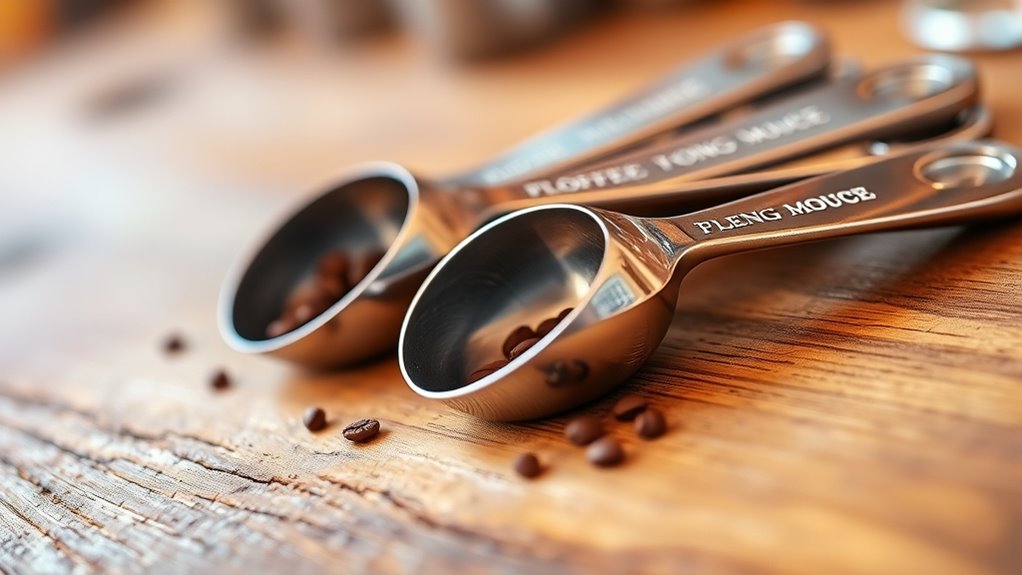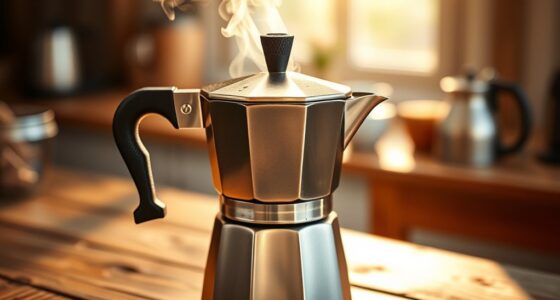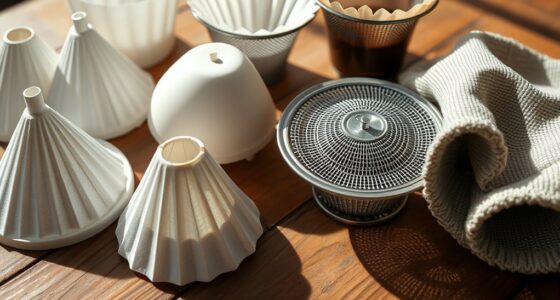To guarantee consistency in your coffee, use a standard coffee scoop that holds about two tablespoons or roughly 10 grams of grounds. Level each scoop to avoid over or underfilling, which affects flavor and strength. Combining scoops with a digital scale helps refine your accuracy and replicate recipes precisely. Maintaining consistent measurements keeps your brew balanced and predictable. Keep exploring, and you’ll discover even more tips to perfect your coffee-making routine.
Key Takeaways
- Use a standard coffee scoop that holds about 2 tablespoons (roughly 10 grams) for consistent measurements.
- Always level the coffee grounds in the scoop to ensure accurate, uniform portions.
- Combine scoops with a digital scale to verify ground weight and improve precision.
- Maintain a consistent scoop size to preserve the optimal coffee-to-water ratio.
- Consistent measurement with scoops ensures reliable flavor and simplifies brewing adjustments.

Have you ever wondered how to measure your coffee accurately for the perfect brew? The key lies in understanding that a standard coffee scoop typically holds about two tablespoons of ground coffee, which is roughly 10 grams. This measurement has become a widely accepted baseline because it helps you achieve consistent flavor with each brew.
While coffee scoops can come in different designs, most conform to this standard, making it easier to follow recipes and maintain uniformity. Using a standard scoop ensures each serving contains the right amount of grounds, preventing weak or overly strong coffee. Of course, you can adjust the amount based on your taste preferences, but sticking to the standard helps you establish a reliable baseline.
Most coffee scoops follow a standard, ensuring consistent servings and better brewing results.
Leveling your coffee scoops is essential for maintaining consistent measurements. When you heap grounds into the scoop, you add more than intended, which can lead to an overly strong or bitter brew. Conversely, if your scoop is underfilled, your coffee might lack strength and flavor. Taking a moment to level off the grounds ensures each scoop contains exactly two tablespoons, preserving the intended flavor profile.
This small step makes a big difference in the consistency of your coffee, especially if you’re trying to replicate a favorite recipe or experiment with new flavors. Inaccurate measurements can throw off your brew’s balance and diminish your overall coffee experience. Consistently leveling your scoops helps you trust your process and get predictable results.
While coffee scoops are convenient, combining their use with a digital scale can take your precision to the next level. Scoops are great for quick, everyday brewing, but scales provide exact gram measurements, giving you total control over your ratio of coffee to water. For example, if you’re aiming for a specific strength or want to replicate a recipe precisely, weighing your grounds ensures accuracy.
Many coffee enthusiasts use both tools—scoops for speed and scales for precision—making it easier to perfect their brew over time. This approach helps you understand how different amounts of grounds influence flavor, allowing you to fine-tune your process for the best possible cup.
The standard coffee-to-water ratio usually involves about two tablespoons of coffee per serving. Adjusting this ratio affects the strength and extraction of your brew. Using a consistent scoop size helps you stick to this ratio, ensuring a balanced flavor every time.
Different brewing methods might require slight modifications, but understanding the basic ratio is essential for ideal results. When you measure accurately with a scoop and adjust based on taste, you’re more likely to enjoy a smooth, well-rounded cup. Standardized scoop sizes and proper measurement techniques are critical for maintaining the quality and consistency of your coffee, no matter how often you brew.
In the end, consistency is the secret to great coffee. Using a standard scoop helps you replicate your favorite brews reliably, maintaining a uniform flavor profile. Whether you’re a casual drinker or a serious coffee lover, precise measurement makes a noticeable difference.
It simplifies the process, allowing you to focus on enjoying your coffee rather than troubleshooting flavor issues. Many enthusiasts also track their measurements and brewing variables in a journal, helping them refine their technique over time.
Frequently Asked Questions
How Do I Choose the Right Size Coffee Scoop?
When choosing the right coffee scoop, consider your brewing needs and personal taste.
Look for a scoop that holds about 2 tablespoons or 10 grams of coffee, as this is standard.
Test the scoop with water to confirm its size.
Keep in mind factors like bean density, grind size, and brewing method, which may influence how much coffee you prefer per brew.
Adjust accordingly to get your ideal strength.
Are There Different Types of Coffee Scoops?
Yes, there are different types of coffee scoops. You can choose from stainless steel, plastic, or wooden options, each with its own look and feel. Some have long handles for deep containers, while others feature clear measurements for accuracy.
Consider your kitchen style and how you’ll use it—durability, ease of cleaning, and aesthetics matter. Picking the right type helps you measure coffee precisely and makes brewing more enjoyable.
Can Coffee Scoops Be Used for Other Ingredients?
Think of a coffee scoop as a Swiss Army knife—you can definitely use it for more than just coffee. You can measure baking ingredients, spices, tea leaves, or even pet food with it. Just make sure the scoop’s size and shape suit the ingredient, and it’s clean.
Keep in mind, for precise measurements, digital scales or specialized tools might be better, but your scoop’s versatility is quite handy.
How Do I Clean and Maintain Coffee Scoops?
To clean and maintain your coffee scoops, start by rinsing them immediately after use with warm water and dish soap.
For a deeper clean, soak them in white vinegar or use a cleaning solution monthly.
Use a soft brush to scrub away stuck grounds, then dry thoroughly with a microfiber cloth to prevent rust.
Store in a dry, organized spot, and regularly check for signs of wear or buildup to keep them in top shape.
What Materials Are Best for Durable Coffee Scoops?
When choosing materials for durable coffee scoops, stainless steel stands out as the best option. You’ll appreciate its corrosion resistance, strength, and non-reactive qualities that keep flavors pure.
Plus, it’s dishwasher safe and withstands heavy use over years without cracking or tarnishing. Plastic scoops may be cheaper initially, but they tend to wear out quickly.
For long-term durability and ease of maintenance, stainless steel is your top choice.
Conclusion
Using the right coffee scoop is like having a secret recipe for perfect mornings. It guarantees every cup is just right, so you can start your day with confidence and flavor. Think of your scoop as a trusted partner, helping you measure out the perfect amount every time. With consistency in your hands, brewing becomes an art you master effortlessly—turning a simple ritual into a delightful daily celebration.









